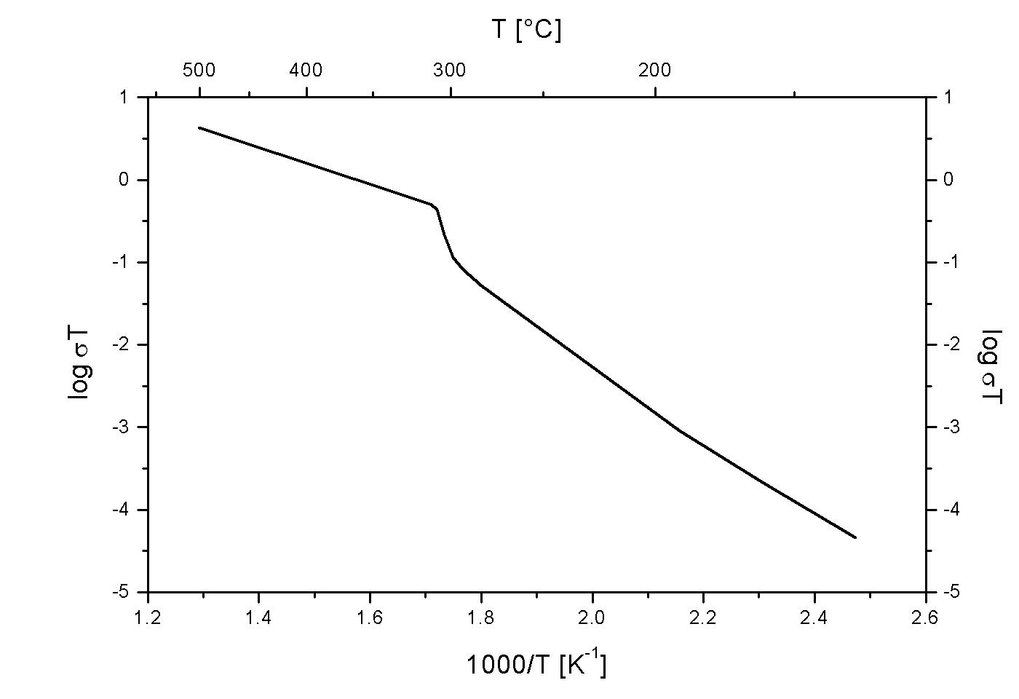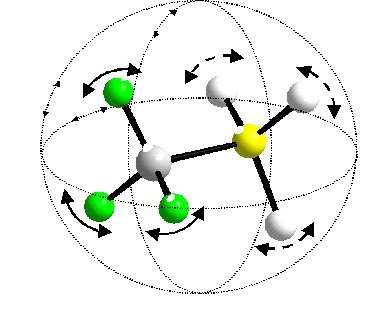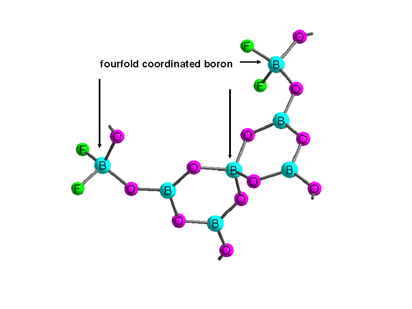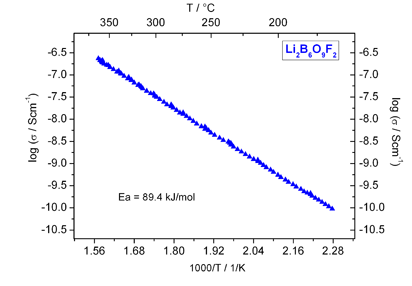
Ionconductivity
Ionic conductors are of great interest for solid state batteries, fuel cells, sensors, electro chromic devices and electrochemically memory devices.
Developing a battery with high energy density is a great future challenge. This concerns the electrode materials as well as the electrolyte.
The selection of an electrolyte for practical application in lithium ion batteries often involves a tradeoff between hazards (flammability of well
conducting liquid electrolytes) and electrochemical performance.
For lithium ion batteries, the electrolyte must satisfy several requirements such as:
- High ionic (σ > 10-4 Scm-1) and low electronic conductivity (σ < 10-10 Scm-1)
- Large electrochemical window to avoid redox reaction with the electrode material
- Nonflammable and nontoxic material (in contrast to organic liquid electrolytes)
- Transference number σ(Li) / σ(total) ≈ 1 (immobile anionic matrix)
- Chemical stability at temperatures in the battery under high power
- Light material (high weight capacity)
The fundamental prerequisites for high conductivity are high concentration and high long range mobility of charge carriers. In order to allow a good
long range mobility of charge carriers, the anionic matrix needs to provides two, or better three dimensionally branched migration path along which
the ion experience a flat electrostatic potential profile, which means a low activation energy for migration of ions between occupied and vacant sites.
Our approach:
We try to develop in a chemical sense new electrolytes. The guideline we follow is studying to decrease the potential barrier along the ions migration
path by paddle wheel mechanism and to shield the negative charge of anionic matrix by borate based solid ionics. The former is realized in phosphates
and triflates and the latter in fluorooxborates.
In at least some of the triflates and phosphates, the ionic mobility is greatly enhanced of a phase transition to a rotationally disordered high temperature
phase ('paddle wheel mechanism (A. Kvist, A. Bengtzelius in W. van Gool (Ed.), Fast Ion Transport in Solids- Solid State Batteries and Devices,
North-Holland, Amsterdam 1973, p. 193), (M. Jansen: Volume effect or paddle-wheel mechanism - fast alkali-metal ionic conduction in solids with rotationally
disordered complex anions, Angew. Chem. 103 (1991) 1574; Angew. Chem. Int. Ed. Engl. 30 (1991) 1574 )), thus lowering the potential energy barriers
along the pathways of the cations (Fig.1). In this context, the alkali salts of the trifluoromethane sulfonate acid (triflates) are of special interest regarding
the diverse possible rotational degrees of freedom (Fig.2).


Fig.1 Fig.2
Fig.1: Sharp increase in the ionic conductivity at the transition to the rotational disordered modification of Na3PO4.
Fig.2: Possible rotations of the triflate anion. Apart from the CF3- reorientation (solid arrows) and the SO3-reorientation
(dashed arrows), a reorientation of the complete triflate anion (dotted lines) is possible.
Fluorooxoborates with direct B-F –linkage are very rare. The anionic matrix appears to be promising to provide long range mobility for cations, because
the negative charge of the terminal oxygen atom in borates is shifted to the fourfold coordinated boron atom (Fig. 3). This avoids ion trapping at the
terminal oxygen atoms therefore we regard lithium fluorooxoborates to be good candidates for lithium ion conductors.


Fig.3 Fig.4
Fig.3: Fundamental building block of Li2B6O9F2
Fig.4: Ionic conductivity of Li2B6O9F2
We have synthesized three new lithium fluorooxoborates. These are LiB6O9F, Li2B6O9F2 and Li2B3O4F3. LiB6O9F exhibits a layer structure according
∞2[B6O9F6]-, Li2B3O4F3 a chain according ∞1[B3O4F3]2- and Li2B6O9F2 a three-dimensional network according ∞3[B6O9F2]2-.
The ionic conductivities are measured by impedance spectroscopy. This is a very useful and non- destructive method for electrochemical characterization
of materials. The AC resistance of a sample (impedance) is measured over a wide range (0,01 Hz- 20 MHz) of a sinusoidal field. This method enables us
to separate and analyze electrochemical processes (like e.g. conductivity in a bulk or along the grain boundaries, effects at the electrodes, diffusion etc.)
with different time constants within the sample. In combination with additional methods, like X- ray diffraction or solid state NMR, it is possible to analyze
the dynamical processes in a structure at different temperatures.
Publications
- M. Jansen: Volumeneffekt oder Drehtürmechanismus - schnelle Alkalimetall-Ionenleitung in Festkörpern mit rotationsfeldgeordneten komplexen Anionen
Angew. Chem. 103 (1991) 1574; Angew. Chem. Int. Ed. Engl. 30 (1991) 1574 - M. Witschas, H. Eckert, H. Freiheit, A. Putnis, G. Korus, M. Jansen: Anion rotation and cation diffusion in low- temperature sodium orthophosphate: results form solid-state NMR
J. Phys. Chem. A 105 (2001) 6808-16 - G. Korus, M. Jansen: Kristallstruktur, Phasenumwandlung und Kaliumionenleitfähigkeit von Kaliumtrifluormethylsulfonat
Z. Anorg. Allg. Chem. 627 (2001) 1599-605 - M. Pompetzki, M. Jansen: Natriummonothiophosphat(V): Kristallstruktur und Natriumionenleitfähigkeit
Z. Anorg. Allg. Chem. 628 (2002) 641-46 - M. Pompetzki, R. E. Dinnebier, M. Jansen: Sodium dithiophosphate(V): crystal structure, sodium ionic conductivity and dismutation
Solid State Sci. 5 (2003) 1439-44 - M. Pompetzki, K. Friese, M. Jansen: Twinned α-LiRb2(CF3SO3)3
Acta Crystallogr. C 59 (2003) 117-119 - N. Sofina, E.- M. Peters, M. Jansen: Kristallstrukturanalyse und Natriumionenleitung von wasserfreiem α- Natriumtrifluormethylsulfonat
Z. Anorg. Allg. Chem. 629 (2003) 1431-6 - M. Pompetzki, L. van Wüllen, M. Jansen: The system LiSO3CF3/RbSO3CF3: Phase diagram, solid-state NMR investigations, and ionic conductivity
Z. Anorg. Allg. Chem. 630 (2004) 484-490 - R. Dinnebier, N. Sofina, M. Jansen: The structure of the high temperature modification of lithium triflate (γ-LiSO3CF3)
Z. Anorg. Allg. Chem. 630 (2004) 1613-1616 - L. van Wüllen, N. Sofina, M. Jansen: Cation mobility and anion reorientation in sodium trifluoromethylsulfonate, NaSO3CF3
Chem. Phys. Chem. 5 (2004) 1906-1911 - G. Cakmak, J. Nuss, M. Jansen: LiB6O9F, the first lithium fluorooxoborate - crystal structure and ionic conductivity
Z. Anorg. Allg. Chem. 664 (2009) 631-636